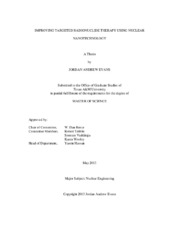| dc.description.abstract | The objectives of this thesis are to produce radioactive antibody-conjugated gold nanoparticles to improve the efficacy of targeted radionuclide therapy for the treatment of cancer, and to demonstrate that this product can be produced at Texas A&M University.
We have proposed a method for determining the distribution of radioactive nuclei per nanoparticle, which is critical for determining radiotherapeutic efficacy. Using the distribution of radioactive nuclei per nanoparticle, we have produced methods for calculating the radiative dose to tissue using nano-improved targeted radionuclide therapy, but more importantly we propose procedures to experimentally determine the efficacy of targeted radionuclide therapy improved by application of radioactive nanomaterials in combination with immunotherapy, nanomaterial cytotoxicity, and other cancer therapies such as chemotherapy. These methods can also be used to determine the efficacy of combinatory treatments as a function of time.
Characterization of the antibody-nanoparticle attachment is critical; we have demonstrated successful antibody-nanoparticle conjugation using atomic force microscopy, dynamic light scattering, and agarose gel electrophoresis, providing more conclusive evidence of successful conjugation compared to flow cytometry.
We provide a mathematical derivation from basic electron-transport principles which demonstrates the theoretical dosimetric advantages of applying radioactive nanomaterials to targeted radionuclide therapy. The general formulae can be applied to any tumor size, any radionuclide, and any pharmacokinetic nanoparticle distribution throughout the body, ultimately allowing a quick method of approximating the necessary activation time and treatment dosage parameters for a specific patient without burdensome Monte Carlo computational simulations.
We further demonstrated that nano-TRT dosage to tumors should be considered as a function of radial position rather than average, as the dose across the tumor may be noticeably non-uniform causing some portions of the tumor to receive (potentially) significantly less dose than average. | en |


